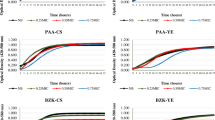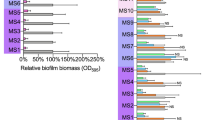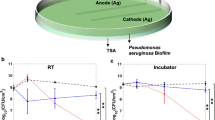Abstract
Methylobacterium sp. is isolated from water distribution systems and has been linked in the biofilms of the systems with a lower presence of Mycobacterium avium. In this study we aimed to determine the in vitro activity of Methylobacterium sp. in the development of rapidly growing mycobacteria (RGM) biofilms. Methylobacterium sp. CECT 7805 was added as a suspension of living bacteria (LB), an autoclaved suspension (AS), and an extract obtained after sonication (ES) at different times (24, 48, and 72 h), to preformed biofilms of Mycobacterium abscessus DSM 44196, Mycobacterium chelonae ATCC 19235, and Mycobacterium fortuitum ATCC 6841, using a 96 h control of each species. The biofilms were analyzed by confocal laser scanning microscopy and by the Calgary biofilm device using the plates MBECTM Biofilm Inoculator. A statistically significant reduction in the thickness and covered surface was observed in all mycobacterial biofilms with all forms of Methylobacterium sp. A statistically significant increase in the autofluorescence was observed in M. abscessus biofilms but not in other biofilms. The increased percentage of dead mycobacteria was statistically significant in all cases. The reduced log CFU (colony-forming units)/peg recount was statistically significant in M. chelonae biofilms after treatment with AS and ES, but in M. fortuitum biofilms the recount decreased only with AS. M. abscessus biofilms were always significantly reduced with AS at 72 h and with ES. Methylobacterium sp. could inhibit RGM biofilm formation. Living cells of Methylobacterium sp. were not necessary to inhibit the growth of a preformed biofilm. M. chelonae biofilms were the most greatly reduced.
This is a preview of subscription content, access via your institution
Access options
Subscribe to this journal
Receive 12 print issues and online access
$259.00 per year
only $21.58 per issue
Buy this article
- Purchase on Springer Link
- Instant access to full article PDF
Prices may be subject to local taxes which are calculated during checkout




Similar content being viewed by others
References
Colombo RE, Olivier KN. Diagnosis and treatment of infections caused by rapidly growing mycobacteria. Semin Respir Crit Care Med. 2008;29:577–88.
Esteban J, et al. Epidemiology of infections due to nonpigmented rapidly growing mycobacteria diagnosed in an urban area. Eur J Clin Microbiol Infect Dis. 2008;27:951–7.
Jitmuang A, et al. Rapidly-growing mycobacterial infection: a recognized cause of early-onset prosthetic joint infection. BMC Infect Dis. 2017;17:802.
Koh WJ. Nontuberculous mycobacteria-overview. Microbiol Spectr. 2017;5:TNMI7-0024-2016.
Brown-Elliott BA, Wallace RJ Jr. Clinical and taxonomic status of pathogenic nonpigmented or late-pigmenting rapidly growing mycobacteria. Clin Microbiol Rev. 2002;15:716–46.
Floto RA, et al. US Cystic Fibrosis Foundation and European Cystic Fibrosis Society consensus recommendations for the management of non-tuberculous mycobacteria in individuals with cystic fibrosis: executive summary. Thorax. 2016;71:88–90.
Benwill JL, Wallace RJ Jr. Mycobacterium abscessus: challenges in diagnosis and treatment. Curr Opin Infect Dis. 2014;27:506–10.
Yu JR, et al. Skin and soft tissue infection due to rapidly growing mycobacteria: case series and literature review. Infect Chemother. 2013;45:85–93.
Esteban J, Garcia-Coca M. Mycobacterium biofilms. Front Microbiol. 2017;8:2651.
Esteban J, et al. Biofilm development by potentially pathogenic non-pigmented rapidly growing mycobacteria. BMC Microbiol. 2008;8:184.
Gomez-Smith CK, LaPara TM, Hozalski RM. Sulfate reducing bacteria and mycobacteria dominate the biofilm communities in a chloraminated drinking water distribution system. Environ Sci Technol. 2015;49:8432–40.
Howard ST, Byrd TF. The rapidly growing mycobacteria: saprophytes and parasites. Microbes Infect. 2000;2:1845–53.
Mullis SN, Falkinham JO 3rd. Adherence and biofilm formation of Mycobacterium avium, Mycobacterium intracellulare and Mycobacterium abscessus to household plumbing materials. J Appl Microbiol. 2013;115:908–14.
Vaerewijck MJ, et al. Mycobacteria in drinking water distribution systems: ecology and significance for human health. FEMS Microbiol Rev. 2005;29:911–34.
Gallego V, Garcia MT, Ventosa A. Methylobacterium hispanicum sp. nov. and Methylobacterium aquaticum sp. nov., isolated from drinking water. Int J Syst Evol Microbiol. 2005;55:281–7.
Gallego V, Garcia MT, Ventosa A. Methylobacterium adhaesivum sp. nov., a methylotrophic bacterium isolated from drinking water. Int J Syst Evol Microbiol. 2006;56:339–42.
Lee SW, et al. Methylobacterium dankookense sp. nov., isolated from drinking water. J Microbiol. 2009;47:716–20.
Yano T, et al. Stress tolerance of Methylobacterium biofilms in bathrooms. Microbes Environ. 2013;28:87–95.
Kovaleva J, Degener JE, van der Mei HC. Methylobacterium and its role in health care-associated infection. J Clin Microbiol. 2014;52:1317–21.
Lai CC, et al. Infections caused by unusual Methylobacterium species. J Clin Microbiol. 2011;49:3329–31.
Sanders JW, et al. Methylobacterium mesophilicum infection: case report and literature review of an unusual opportunistic pathogen. Clin Infect Dis. 2000;30:936–8.
Feazel LM, et al. Opportunistic pathogens enriched in showerhead biofilms. Proc Natl Acad Sci USA. 2009;106:16393–9.
Munoz Egea MC. et al., Inhibition of adherence of Mycobacterium avium to plumbing surface biofilms of Methylobacterium spp. Pathogens. 2017;6:42.
Falkinham JO 3rd, et al. Mycobacterium avium in a shower linked to pulmonary disease. J Water Health. 2008;6:209–13.
Munoz-Egea MC, et al. Effect of antibiotics and antibiofilm agents in the ultrastructure and development of biofilms developed by nonpigmented rapidly growing mycobacteria. Micro Drug Resist. 2016;22:1–6.
Munoz-Egea MC, et al. Autofluorescence as a tool for structural analysis of biofilms formed by nonpigmented rapidly growing mycobacteria. Appl Environ Microbiol. 2013;79:1065–7.
Ceri H, et al. The calgary biofilm device: new technology for rapid determination of antibiotic susceptibilities of bacterial biofilms. J Clin Microbiol. 1999;37:1771–6.
Herigstad B, Hamilton M, Heersink J. How to optimize the drop plate method for enumerating bacteria. J Microbiol Methods. 2001;44:121–9.
Falkinham JO 3rd, et al. Methylobacterium spp. as an indicator for the presence or absence of Mycobacterium spp. Int J Mycobacteriol. 2016;5:240–3.
Bridgeman J, et al. Portable LED fluorescence instrumentation for the rapid assessment of potable water quality. Sci Total Environ. 2015;524-525:338–46.
Patino S, et al. Autofluorescence of mycobacteria as a tool for detection of Mycobacterium tuberculosis. J Clin Microbiol. 2008;46:3296–302.
Author information
Authors and Affiliations
Corresponding author
Ethics declarations
Conflict of interest
The authors declare that they have no conflict of interest.
Additional information
Publisher’s note: Springer Nature remains neutral with regard to jurisdictional claims in published maps and institutional affiliations.
Rights and permissions
About this article
Cite this article
García-Coca, M., Rodríguez-Sevilla, G., Pérez-Domingo, A. et al. Inhibition of Mycobacterium abscessus, M. chelonae, and M. fortuitum biofilms by Methylobacterium sp. J Antibiot 73, 40–47 (2020). https://doi.org/10.1038/s41429-019-0232-6
Received:
Revised:
Accepted:
Published:
Issue Date:
DOI: https://doi.org/10.1038/s41429-019-0232-6



